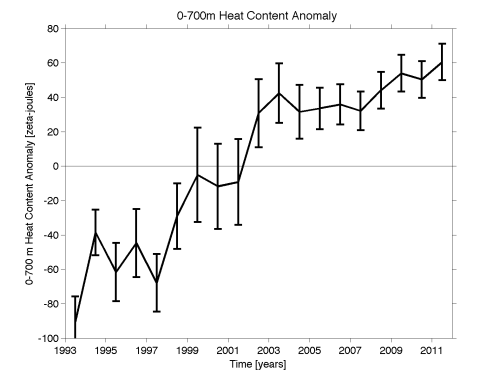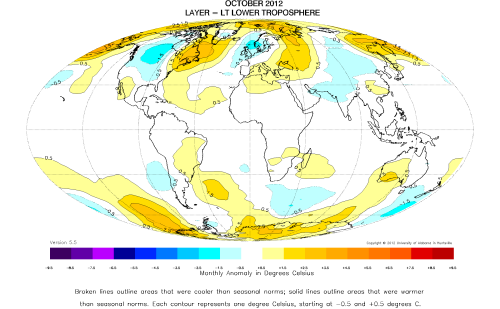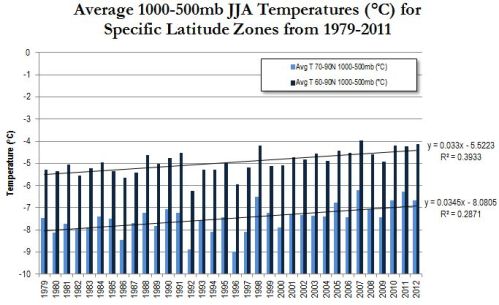
UPDATE OCT 13 2012: The article discussed below is available from here – INDIAN METEOROLOGICAL SOCIETY CHENNAI CHAPTER.
S. Raghavan of the Indian Meteorological Society, Chennai in India has sent us the article below which appeared in the publication Breeze Volume 14 in June 2012. S. Raghavan is a retired Deputy Director-General of Meteorology of the India Meteorological Department. His earlier post on my weblog is
A Perspective on Weather and Climate Science by S. Raghavan
Were 2009 and 2010 the warmest years in India since 1901? by S. Raghavan
1. Warmest years
The India Meteorological Department (IMD) announced in 2010 that 2009 was the warmest year in India since 1901 (Attri and Tyagi, 2010). Again in 2011 it was stated that 2010 was the warmest since 1901 (IMD, 2011). The annual mean temperature for the country as a whole is estimated to have risen by 0.56ºC over the period. This agrees with the widespread perception that the world is warming.
What was the basis for this assessment? The IMD has utilised the records of about 210 surface observatories (including those at major cities) all over India and computed the average of the daily maximum and minimum temperatures at each station. Data have been gridded and weighted average of all grid values has been calculated for the country as a whole. While this is a straightforward process there are certain limitations of the data which need to be considered, as the likely errors in the data could be larger than the “expected” warming due to any climate change.
2. Changes in Land Use
Over the period of more than a century many land use changes have evidently taken place all over the country. The changes in urban areas may be in the form of new structures which can contribute radiation or alter wind circulation. In other areas there can be changes such as development of irrigated lands, change in farming practices, drying up or filling up of water bodies and removal of vegetation. These changes affect the radiation
balance, evaporation, soil moisture and wind flow. The observed increase in temperature can have a component due to land use change and a component due to changes in atmospheric composition and it will be difficult to separate the two.
It is interesting to note that the Inter-Governmental Panel on Climate Change (IPCC) (IPCC, 2012) has recently redefined climate change as
“A change in the state of the climate that can be identified (e.g., by using statistical tests) by changes in the mean and/or the variability of its properties and that persists for an extended period, typically decades or longer. Climate change may be due to natural internal processes or external forcings, or to persistent anthropogenic changes in the composition of the atmosphere or in land use”.
This is different from the previous definition. IPCC states
“This definition differs from that in the United Nations Framework Convention on Climate Change (UNFCCC), where climate change is defined as: “a change of climate which is attributed directly or indirectly to human activity that alters the composition of the global atmosphere and which is in addition to natural climate variability.”
The IMD (Attri and Tyagi, 2010) is therefore correct in listing the trend under “Climate Change Scenario”. However the land use changes in each area and their impact will depend on many factors (meteorological as well as socio-economic) and will be widely different in different areas. Hence the temperature changes may not be compatible among all the stations or the particular station’s own data of earlier decades. An average of the temperatures for the whole country is therefore unlikely to be a good measure of climate change.
3. Deterioration of Exposure Conditions
In case an observatory site is changed, IMD has procedures to compare observations at the new and old sites for ensuring compatibility. But the change in exposure conditions at the same site is difficult to quantify or correct for. In major cities such as Mumbai and Kolkata where the observatories are surrounded by newly developed
roads and buildings, the changes are large and the observatory exposure is drastically affected. In addition to the changes in radiation fluxes and wind flow, even the instruments could have been shadowed in some cases.
It is not often possible to shift the observatory to a more open and representative site to overcome this problem. As different stations are differently affected, the computed country average will be affected.
4. Heat island effect
The heat island effect in cities is well-known. A study organised by the present author at Chennai (Jayanthi , 1991) in the 1980s showed heat island effects of up to 4ºC in some pockets in the minimum temperature epoch in winter. The effect on maximum temperature may be expected to be smaller. The result indicates that the heat island effect
is much larger than any increase which may be expected due to climate change. There may also be effects of changes in local wind circulations due to urban development or due to increasing air pollution. Such an effect will bias the country average.
5. Maximum and minimum temperatures
Maximum and minimum temperatures may be affected differently by land use changes or the heat island effect. Hence an average of the maximum and minimum temperatures may not bring out the correct change over time if any.
6. Network Selection
The basis of selection of the 210 stations for the computation of trend is not clear. Presumably the departmentally manned observatories with long period records which can be expected to have been set up originally with good exposure and yield more reliable data have been selected. Presumably there has been no change in type of instrumentation or observing practices at these stations. These need to be verified.
The USA has a Historical Climate Network consisting of a subset of stations of the National Weather Service for Climate change analysis. But even this is said to have several stations with unsatisfactory exposures (Davey and Pielke, 2005). More recently a U.S. Climate Reference Network (CRN) has been established (Vose et al., 2005). The
IMD also maintains a network of 10 Global Atmosphere Watch stations (GAW, formerly Background Air Pollution Monitoring Network or BAPMoN) as per WMO protocols and standards (Attri and Tyagi 2010). These may perhaps have a record which has not been significantly affected by the above effects but these stations are available only from 1974. They are few in number and widely different in geographical distribution and in topographic characteristics. Hence they may also not be representative of the country. The optimum station density network for assessing trends may need to be determined (See e.g. Voss and Menne, 2004).
7. Correction of data
Evidently while assessing long-term trends the impact of these effects has to be minimised. How is this to be done?
The stations to be included in the analysis can be reviewed to exclude those which are affected by significant heat island effect or exposure deterioration. A station by station check is necessary to exclude those which have poor or non-standard exposures or are unrepresentative in other respects. Techniques for “homogeneity adjustments” have
been suggested (e.g. Easterling et al., 1996). Another method suggested is to use temperature anomalies instead of the temperatures themselves because temperature anomalies are expected to be much more geographically coherent than actual temperatures (Peterson, 2006).The anomaly time series is derived by subtracting the mean
temperature from a base period. Such corrections need to be effected before announcing to the public the rise in the temperatures.
8. Significance and interpretation of temperature trends
How to interpret the trends corrected as suggested and use the information?
There is a widespread view among scientists that near-surface temperature is not the most reliable metric to assess climate change. Other parameters such as ocean heat content have been suggested as most of the energy received by the earth is stored in the oceans (e.g. Ellis et al. 1978). Publishing a temperature trend without interpreting it may cause the public to derive wrong conclusions. For example the public and the media often state and feel during every summer that the current summer is hotter than any they experienced earlier. They interpret this as climate change. This perception is in most cases not correct.
As discussed earlier, whether the observed trend is due to land use change or change in atmospheric composition, it is to be considered as climate change. But the actions to be taken to minimise the trend will be different in the two cases. The meteorological community should be able to advise decision-makers about measures to be taken in the two cases. Any information which goes to users should put these issues in proper perspective.
References
Attri S. D. and A Tyagi, 2010, “Climate Profile of India” by Met Monograph No. Environment Meteorology-01/2010
Davey, C. A., and R. A. Pielke Sr., 2005: Microclimate exposures of surface-based weather stations. Bull. Amer. Meteor. Soc., 86, 497–504.
Easterling, D. R., T. C. Peterson, and T. R. Karl, 1996, On the development and use of homogenized climatological datasets. J. Climate, 9, 1429–1434.
Ellis J. S., T. H. Vonder Haar, S. Levltus and A. H. Oort, 1978, The Annual Variation in the Global Heat Balance of the Earth, J. Geophys. Res., 83, 1958-1962IMD. 2011, Press Release dated 13 January 2011
IPCC, 2012: Summary for Policymakers. In: “Managing the Risks of Extreme Events and Disasters to Advance Climate Change Adaptation” [Field, C.B., V. Barros, T.F. Stocker, D. Qin, D.J. Dokken, K.L. Ebi, M.D. Mastrandrea, K.J. Mach, G.-K. Plattner, S.K. Allen, M. Tignor, and P.M. Midgley (eds.)]. A Special Report of Working Groups I and II of the Intergovernmental Panel on Climate Change. Cambridge University Press, Cambridge, UK, and New York, NY, USA, pp. 1-19. (available on IPCC website).
Jayanthi N., 1991, Heat Island study over Madras city and neighbourhood, Mausam, 42, 1, 83-88.
Vose R.S,, D. R. Easterling, T. R. Karl and M. Helfert, 2005, “Comments on “Microclimate Exposures of Surface-Based Weather Stations”, Bull. Amer. Meteor. Soc., 86, 504-506.
Vose, R. S., and M. J. Menne, 2004: A method to determine station density requirements for climate observing networks. J. Climate, 17, 2961–2971.
source of image
















